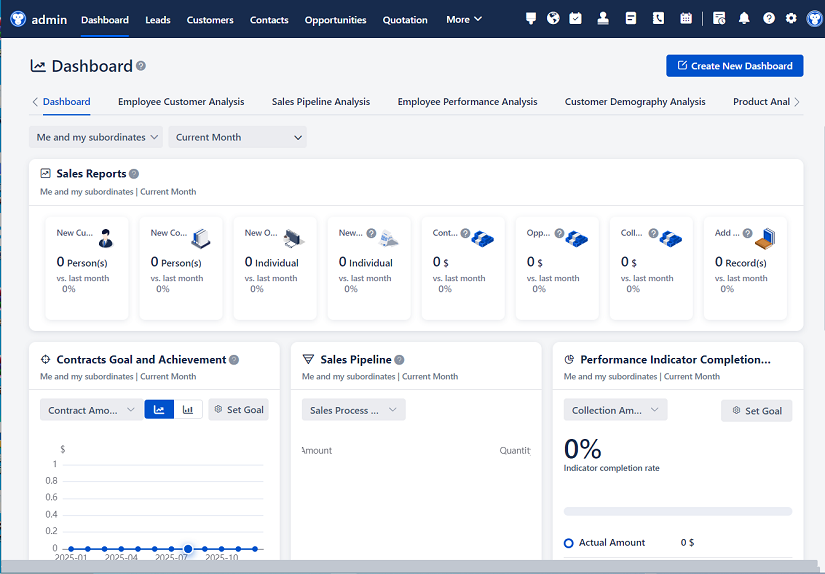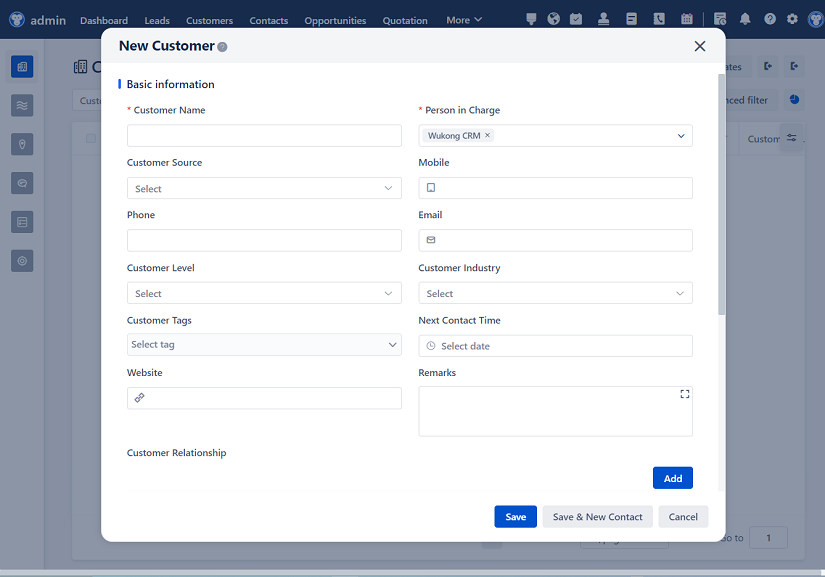
△Click on the top right corner to try Wukong CRM for free
So, you know how everyone’s always talking about CRM systems these days? Like, every business seems to be jumping on the bandwagon, trying to get their customer relationship management game strong. But here’s the thing—have you ever stopped and thought, “Wait, why does one CRM cost so much more than another?” I mean, it’s not like they all come with a golden button or something. There’s actually a whole bunch of reasons behind those price tags, and honestly, it’s kind of fascinating once you start digging into it.
Let me tell you, when I first started looking into this, I assumed it was just about features. More features, higher price—makes sense, right? But then I realized it’s way more complicated than that. It’s not just what the software does, but how it does it, who it’s for, where it runs, and even how easy it is to use. All of these things play a role in shaping the final price.
Free use of CRM system: Free CRM
Take scalability, for example. If a company wants a CRM that can grow with them—from a small startup to a multinational corporation—that system has to be built differently. It needs robust architecture, better security, and more advanced support options. And guess what? That doesn’t come cheap. So naturally, vendors charge more for systems designed to scale because they’re investing more in development and infrastructure.

And speaking of infrastructure, have you considered whether the CRM is cloud-based or on-premise? That makes a huge difference. Cloud CRMs are usually subscription-based, which means you pay monthly or annually. They’re easier to set up, update automatically, and don’t require you to manage your own servers. On the flip side, on-premise solutions often have a massive upfront cost—you’re buying licenses, setting up hardware, hiring IT staff to maintain it. But some big companies still prefer that model because they want full control over their data. So depending on the deployment method, the pricing structure changes completely.
Now, let’s talk about customization. Some businesses need their CRM to fit like a glove—specific workflows, unique reporting tools, integration with legacy systems. The more customizable a CRM is, the more complex it becomes to build and maintain. Developers have to create flexible frameworks, add APIs, allow for deep configuration. All of that effort gets reflected in the price. Meanwhile, simpler CRMs that offer a one-size-fits-all approach tend to be cheaper because there’s less engineering overhead.
Integration capabilities are another big factor. Think about it—your CRM doesn’t live in a vacuum. It needs to talk to your email platform, your marketing automation tool, your ERP system, maybe even your e-commerce site. The more third-party apps it can connect with seamlessly, the more valuable it becomes. But building and maintaining those integrations takes time and resources. Vendors either do it themselves or rely on open APIs, but either way, it adds to the cost. So if you see a CRM that integrates with 50 different tools out of the box, yeah, that’s going to cost more than one that barely connects to anything.
User experience matters too—more than you might think. A CRM that’s intuitive, clean, and easy to navigate reduces training time and increases adoption across teams. Companies are willing to pay extra for that because they know a clunky system will just sit unused. Design isn’t free, though. UX research, user testing, iterative design—all of that goes into making a CRM feel smooth and natural. So when you’re paying for a premium CRM, part of that money is going toward making sure people actually want to use it.
Then there’s the size of your team. Most CRM providers tier their pricing based on the number of users. Add five sales reps? That’ll bump you up a tier. Hire ten more? Now you’re in enterprise territory. It makes sense from a business perspective—more users mean more demand on servers, more support requests, more data being processed. But it also means the total cost can spiral quickly if you’re not careful. I’ve seen companies underestimate how fast those per-user fees add up.
Support and service levels are another hidden cost driver. Basic plans might give you email support during business hours, but if you want 24/7 phone support, dedicated account managers, or on-site training, that’s going to cost extra. Enterprise clients often pay a premium just for faster response times and personalized assistance. After all, downtime costs money, and big companies can’t afford to wait three days for a ticket reply.
Security and compliance are non-negotiables, especially in industries like healthcare or finance. A CRM handling sensitive customer data has to meet strict regulations—GDPR, HIPAA, SOC 2, you name it. Achieving and maintaining those certifications isn’t easy or cheap. It requires audits, encryption protocols, regular penetration testing, and ongoing monitoring. So naturally, CRMs built for regulated industries come with higher price tags to cover those compliance costs.
Oh, and don’t forget about analytics and reporting. Basic CRMs might show you a few charts and sales numbers, but advanced ones offer predictive analytics, AI-driven insights, real-time dashboards, and custom report builders. These features rely on powerful data processing engines and machine learning models, which again, cost money to develop and run. If you want your CRM to not just store data but make sense of it, you’re going to pay more.
The target market also plays a role. A CRM built for small businesses—like HubSpot’s free tier or Zoho CRM’s starter plan—is priced to be accessible. But Salesforce or Microsoft Dynamics? Those are aimed at large enterprises with deep pockets. They offer deeper functionality, stronger SLAs, and more customization, so their pricing reflects that audience. It’s kind of like comparing a Honda Civic to a Mercedes-Benz—both get you from point A to point B, but one comes with a lot more under the hood.

Brand reputation and ecosystem matter too. Salesforce didn’t become the market leader overnight. They’ve spent years building trust, expanding their AppExchange, training consultants, and creating a whole community around their platform. That kind of ecosystem adds value—and yes, it adds cost. When you buy into a major CRM brand, you’re not just paying for software; you’re paying for reliability, a vast support network, and access to thousands of pre-built integrations.
Implementation and onboarding services are another piece of the puzzle. Sure, some CRMs claim to be “easy to set up,” but in reality, getting everything configured properly—importing data, mapping workflows, training staff—can take weeks or months. Many companies end up hiring consultants or paying the vendor for professional services. Those fees aren’t always included in the base subscription, so the total cost of ownership ends up being much higher than the sticker price suggests.
And let’s not ignore innovation and R&D. The best CRMs are constantly evolving—adding AI features, improving mobile access, enhancing automation. Staying ahead of the curve means investing heavily in research and development. Those costs get passed on to customers. So when you choose a cutting-edge CRM, you’re essentially helping fund future improvements, even if you don’t realize it.
Market competition influences pricing too. In crowded spaces, vendors might lower prices or offer discounts to attract customers. But in niche markets—say, CRMs for real estate agencies or law firms—there are fewer options, so providers can charge more. Limited competition means less pressure to cut prices, even if the product isn’t dramatically better.

Geographic location can affect pricing as well. A CRM might cost more in North America than in Southeast Asia due to differences in purchasing power, local taxes, or regional support requirements. Some vendors even adjust pricing based on currency fluctuations or local data residency laws. So two identical subscriptions could have different price points just based on where the company is located.
Finally, long-term contracts versus month-to-month plans make a difference. Committing to a three-year deal often comes with a discount, while rolling month-to-month gives flexibility but at a higher rate. It’s a trade-off between cost savings and freedom. And honestly, a lot of businesses don’t realize how much they could save—or overspend—based on their contract length.
So when you step back and look at it, CRM pricing isn’t arbitrary. It’s shaped by a mix of technology, strategy, market forces, and customer needs. You’re not just paying for software—you’re paying for peace of mind, scalability, support, security, and the ability to grow without hitting a wall.
It’s kind of like buying a car. You could go for the basic model with manual windows and no GPS, or you could upgrade to leather seats, adaptive cruise control, and a killer sound system. Both will get you where you’re going, but one offers a smoother, safer, more enjoyable ride. Same idea with CRMs. The price reflects the entire experience, not just the core features.
At the end of the day, the “right” CRM depends on your specific needs, budget, and long-term goals. There’s no one-size-fits-all answer. But understanding why prices vary helps you make smarter decisions. Instead of just looking at the number on the screen, you start asking, “What am I really paying for?” And that’s when you begin to see the true value behind the price tag.
FAQs (Frequently Asked Questions):
Q: Why do some CRMs cost thousands per month while others are free?
A: Great question! Free CRMs usually have limited features, user caps, and minimal support. Paid ones offer advanced tools, scalability, security, and service—so you’re paying for capability and reliability.
Q: Does a more expensive CRM always perform better?
Not necessarily. A pricier CRM might have features you don’t need. The best choice fits your business size, industry, and goals—not just your budget.
Q: Can I negotiate CRM pricing?
Absolutely! Especially for enterprise plans. Vendors often offer discounts for long-term commitments, bundled services, or large user counts. Always ask.
Q: Are cloud CRMs cheaper than on-premise ones?
In the short term, yes—cloud CRMs usually have lower upfront costs. But over time, subscription fees can add up. On-premise has high initial costs but may be cheaper long-term if you already have IT infrastructure.
Q: How do integrations affect CRM pricing?
Some integrations are free, but many require paid add-ons or premium tiers. The more complex the integration (like syncing with an ERP), the more it may cost.
Q: What’s the biggest hidden cost in CRM pricing?
Implementation and training. Even if the software seems affordable, setup, data migration, and user onboarding can significantly increase total expenses.
Q: Should small businesses avoid expensive CRMs?
Not always. If you’re planning rapid growth, investing in a scalable CRM early might save money and headaches down the road. Just make sure it aligns with your roadmap.
Q: Do CRM vendors offer nonprofit or startup discounts?
Yes, many do! Salesforce, HubSpot, and others have special programs for startups and nonprofits. Always check—they can slash costs dramatically.
Related links:
Free trial of CRM
Understand CRM software

△Click on the top right corner to try Wukong CRM for free